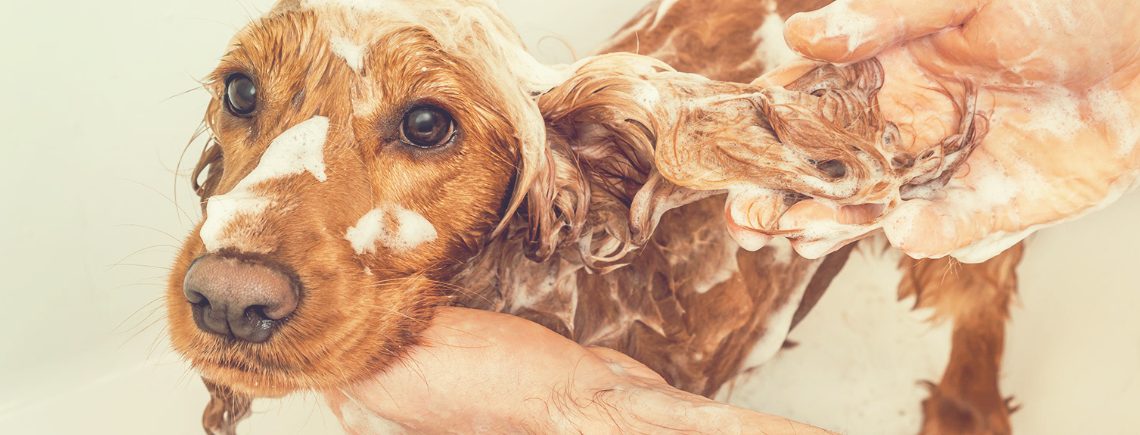Looking After Your Dog’s Skin and Coat
Here at Petmania Grooming Studios, we are always assessing your dog’s health and wellbeing while they’re with us. One thing we inspect thoroughly is the skin and coat of your dog. A healthy coat should be shiny, glossy and smooth, and healthy skin should be supple and clear. It should not be greasy, flaky, or bumpy.
Regular brushing and grooming of your dog’s coat and a healthy, nutritious diet are two effective ways to ensure your dog’s coat is kept in the best condition possible. Brush your dog frequently to ensure they are free of tangles and mats, as they can be very uncomfortable for your dog.
In this blog post, you’ll find out the different types of coats dogs have and how to look after them, some common skin issues we frequently see in the grooming studios, and the best practices to keeping your doggie’s coat shiny and healthy.

Michelle Walsh, Professional Dog Groomer
Michelle Walsh is a Professional Dog Groomer with over 10 years experience caring for puppies and dogs at Petmania Grooming Studios. She is also a Grooming Trainer for the Petmania Grooming Academy. Michelle is the human companion to Luna and is based a Petmania Grooming Studio in Santry.
What are the different types of hair coat that a dog might have?
- Short e.g. a Labrador. Make sure to brush regularly with a SAFARI Bristle Brush to remove any dead hair.
- Smooth e.g. Jack Russell Terrier. Brush your dog’s coat once a week for the best results. Brush using a Bristle Brush (same as above) in the opposite direction of hair growth to remove any dead hairs. Then, brush in the direction of hair growth to get rid of any remaining hairs.
- Double e.g. Border Collie. Make sure to brush very regularly. An undercoat specific grooming rake, such as the SAFARI Double Row Undercoat Rake, will help remove any loose hairs from your pets inner coat and prevent matting.
- Straight/smooth e.g. Yorkshire terrier. Using a Safari Soft Slicker Brush and comb, start at your dog’s neck and work backwards, incorporating long strokes to eradicate dirt and hair.
- Curly/woolly coat e.g. bichon/poodle. A dog with a curly or wool coat requires consistent brushing to get rid of tangles from the fur. Brush with a soft slicker brush such as the Safari Soft Slicker Brush. Start by parting the hair, brush from root to tip, working through any tangles gently but firmly. For more on brushing your curly haired dog, check out our blog post.
- Wire coat e.g. cairn terrier. A dog with a wiry coat should be brushed twice a week with a slicker brush such as the SAFARI Self-Cleaning Slicker Brush– simply brush your dog in the direction the coat is growing to remove any tangles.

Common Coat Issues
The most common coat issues we see as groomers is matting of the dogs coat. Matting fur on your dog’s coat is caused by the hairs becoming entangled with each other as they wrap around loose and live fur. Without regular brushing, matts will gather more hair and dirt; causing them to become tighter against the skin, and making them more difficult to remove.
If your dog has slightly matting fur, we would expect to be able to remove it by using a special de-matting treatment. We could also clip them out and finish your dog’s overall cut in a way that the de-matted areas are less noticeable. However, if your dog is badly matted, we will need to spend more time shaving the affected areas, and may even a few trips to the studios or be seen by a vet.
Common Skin Issues
The most common skin issue we see is dry itchy flaky skin. There are a few different reasons why a dogs may get itchy and dry skin, including allergies, parasites or infections. Some breeds are more prone to skin conditions than others, such as West Highland Terriers, English bulldogs, and Pitbull terriers.
If you notice your dog has dry skin, it’s important to consult with your vet about the best course of action to take to treating your dog. They may recommend a sensitive skin-friendly shampoo, change diets, regular grooming, or if there is serious skin issues, medication.
Symptoms of skin issues include itchiness, dandruff, flaking, hair loss, inflammation, odour, increased oiliness and scabs.
Best Practices To Keep Your Dog’s Coat Healthy
- Brush and comb your dog as often as needed per breed (some dogs everyday some once a week)
- Have your dog professionally groomed every 6 to 8 weeks
- When washing your dog at home make sure all product is washed out before drying, as this can cause skin issues
- Let your groomer know that your dog is sensitive and has a skin issue, as we can advise you what is the best treatment to go with and if further investigation is needed from your vet.

